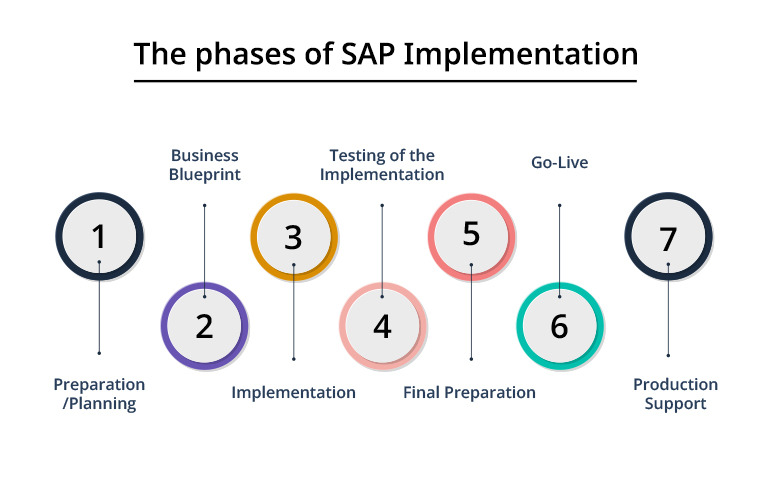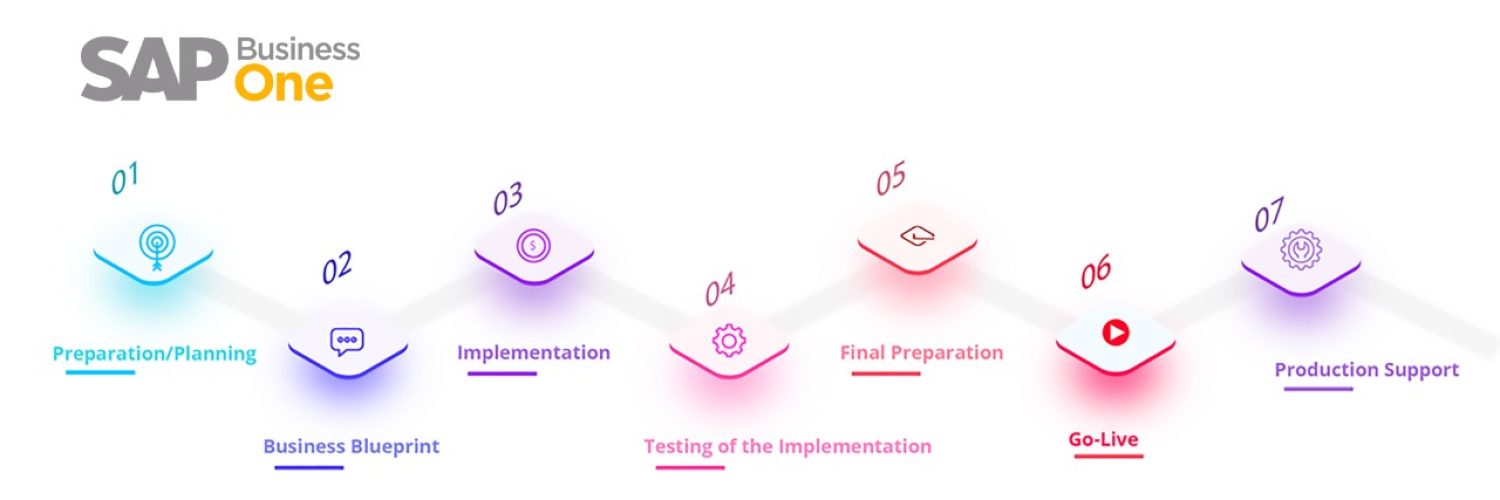Almost every company’s backbone today is made up of SAP applications. As a result, business owners make every effort to ensure that SAP implementation is a success. But despite all the steps and struggles, numerous SAP implementations struggle to succeed. It is said that the chances of success with customized SAP applications are 50-50. That’s because many businesses don’t get the starting right.
For every successful SAP implementation, it is essential to consider, plan, and follow all the key stages of SAP implementation. Otherwise, failure becomes the very next step.
Here we will discuss the step-by-step procedure of SAP implementation so that not even a single casualty is caused and your chances of success are greatly improved.
But before all of that good stuff, we must understand what SAP implementation is.
What is SAP Implementation?
SAP implementation, or Systems, Applications, and Product implementation is a process that outlines an enterprise resource planning software implementation strategy in any firm. This technique explains the introduction of a generic methodology rather than a specific one, and it includes the whole implementation method that allows platforms to plan and execute software.
It is based on best practices and case studies. SAP deployment is a large-scale operation that can result in numerous changes to an organization’s operations, and creating an appropriate setup that strikes the balance just right might even take several years.
SAP installation has gone a long way towards smoothing corporate processes and enhancing overall business growth. The complexity of many tasks involved with such initiatives is time-consuming and resources but also provides improved services. In the long run, it streamlines the process, giving the company a competitive advantage and speeding its growth.
Steps of SAP Implementation
SAP project implementation is a lengthy and intensive process that necessitates a significant amount of effort and resources on the part of developers. SAP implementation has various aspects, including each stage of the project’s software development life cycle (SDLC). It also splits the project into the required phases, with each phase serving as a milestone.
Thus,
The phases of SAP Implementation are:

- Preparation/Planning – This is the start phase and it is the most crucial phase that can make or break the SAP implementation project. It entails designing the complete project while taking into account all of the nuances and aspects, which can be difficult given the huge landscape. As a result, choosing one of the top SAP installation partners, or SAP MSPs like Fairfax Solution is critical. They may assist you in a variety of methods in order to establish the most effective SAP roadmap.
- Business Blueprint – The SAP Cloud Computing Services Business Blueprint covers the SAP product’s core modules as well as the mapping of existing business processes to SAP. It entails describing the actual business process for dealing with the situation. In this phase, it’s critical to properly implement the programme and identify the retailing that needs to be done. It involves a series of seminars that must be organised in tandem with everyone associated with the project. It is critical to fully comprehend and outline your future company procedures. Between your existing and future business processes, there will always be certain disparities or gaps. The creation of a blueprint document will aid in the mitigation of these flaws and ensure a seamless SAP implementation.
- Implementation – Your SAP installation partner will configure your baseline system, also known as the baseline configuration, once the gap analysis is completed. To ensure a smooth SAP implementation, the implementation team fine-tunes the system to match all of your business and process needs and eliminates all gaps detected in the business blueprint. The SAP implementation team will also take care of any adjustments that are required during this phase. It basically comprises active customization of the existing package and solution, as well as the creation of original objects depending on the requirements.
- Testing of the Implementation – The testing phase runs parallel to the migration and implementation, it goes hand-in-hand with the Realization phase. The testing team conducts various tests (Unit and Integration tests) to assess how well the deployment is progressing and to confirm that the SAP systems are delivering accurate and expected results. The integration phase is divided into several different settings. Only half of the present process may be migrated and tested in the first setup. Another scenario is to test a whole process once it has been implemented on the SAP landscape. Finally, the entire process and workload are put to the test.
- Final Preparation – The production system is constructed using the changes discovered during the realisation and testing phases. Certain operations, such as the final preparation phase, must also be performed directly for the production system. Any SAP development business takes the essential preparations for migration and goes live at this stage, as it entails final preparations that are not only system-related but also people-related. Every person involved in the project must be trained in the new processes, which include a whole set of processes, data that must be tested, and system validation. This stage serves as a final check before going live to ensure that everything is in working order.
- Go-Live – This is one of the most important steps in the SAP project implementation process, and everyone involved must give in their all. At this stage, even the slightest change, of course, can have a big influence. This phase includes the transition from a pre-production to a live environment and the migration of all data to the SAP systems in the production environment. The old SAP systems are no longer used once all of the data has been moved to the new SAP systems. Along with data migration and the implementation of new apps, project managers will ensure that periodic testing is conducted to guarantee that everything is working properly.
- Production Support – This phase entails the creation of a specialised support team and the handover of responsibility from the implementation team to the support team, who will be responsible for constantly monitoring and resolving any production difficulties. When necessary, the support team will assist users and root users in becoming familiar with SAP systems and applications. To ensure seamless operations, support documentation is mostly created and thereby maintained.
Bidding Words
SAP implementation can be simplified and the total cost of implementation can be reduced by following these seven critical stages. With stronger management and governance, you can achieve all of your business goals.
In terms of subjective or organisational terms, choosing the right strategy can make a tremendous difference to your business, such as bringing stakeholders together and facilitating discussions about their business aspirations for a better landscape. Because of political restraints or hierarchy, these activities can be rather difficult for the in-house staff in the long run. But SAP implementation and strategization can semi-automate these things by facilitating pinpoint precision and unbiased decisions. Fairfax Solution India, being an Authorized SAP Business One Partner in Kolkata, intends to provide solutions to both private and public sector businesses, depending on their needs and requirements following precise and strategic approaches in SAP implementation.





